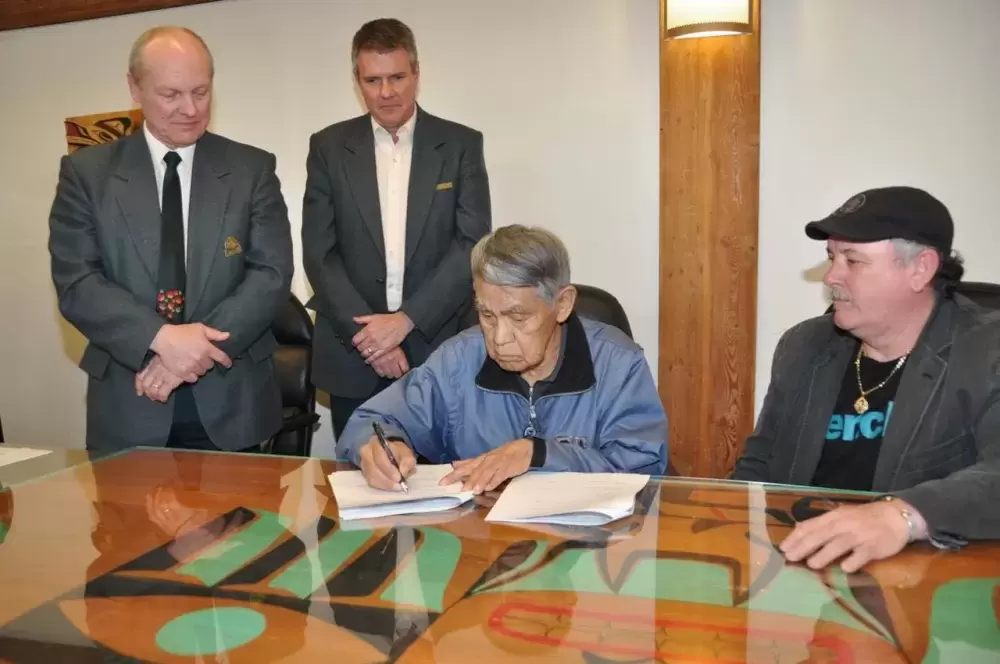Tseshaht First Nation and Parks Canada have signed a historic agreement on planning and management of the Broken Group Islands in Pacific Rim National Park Reserve.
The signing ceremony took place in the Great Room at the Tseshaht administration building on April 19 and included officials from both Parks Canada and Tseshaht, including Ha’wiih Albert Clutesi, who made the trip from Victoria for the event.
“This is the culmination of five years of work,” Tseshaht Chief Councillor Les Sam said. “It actually goes back further than that. When I became chief councilor, I contacted Alex Zellermeyer (then superintendent for Pacific Rim National Park). I told him Tseshaht had to be there, doing cultural guiding and supervising the site, because this is our birthplace.”
Bill Fisher, Parks Canada vice-president for Western and Northern Canada, called the Broken Island Group “one of the most stunning areas on Canada’s West Coast.”
“These islands are also a place with rich human history,” Fisher said. “In 2001, Parks Canada and Tseshaht undertook to collaborate on an archaeological study on Benson Island. This research determined that the site had been occupied for at least 5,000 years. Out of cultural respect for the significance of the site, Benson Island was closed for camping and was commemorated with a house post and an interpretive sign for visitors.”
Parks Canada closed down its Benson Island campsite in 2009. The next year, Tseshaht hired a Patrol Person, Ed Ross, to oversee the Broken Islands. In 2011, the program was renamed Beach Keepers, with a bigger crew of Tseshaht staff.
Fisher said the pubic response to the Tseshaht presence in the Broken Group has been “extremely positive.”
“Recently, Tseshaht also worked with Parks Canada to provide a very memorable season finale for the reality TV show, Operation Unplugged,” Fisher said. “These are just a few of the examples of how working collaboratively benefits not only Parks Canada and Tseshaht First Nation, but also Canada as a whole.”
Sam said the agreement acknowledges Tseshaht aboriginal title in the Broken Island Group, and now opens the way for economic development initiatives such as aboriginal tourism, which would include interpretive guiding and possibly accommodations.
More crucial, perhaps, is the need to protect Tseshaht heritage sites and burial caves against damage caused by visitors.
“Tseshaht had a number of fishing villages in the islands that became displaced when the fisheries were shut down,” Sam said. “We will continue to work with Parks Canada because we don’t have the budget to manage the whole area.”
Sam said for Tseshaht, one of the major reasons for rejecting the 2001 Agreement in Principle, the proposed master treaty for Nuu-chah-nulth nations, was the lack of adequate protection for Tseshaht interests in the Broken Island Group. Those concerns have now been largely addressed, he said.
“Once we sign off on the cooperative work agreement, it’s just the beginning of the work,” he said.
The memorandum of agreement acknowledges both Tseshaht aboriginal title and the Maa-nulth Treaty, signed in 2009 by five Nuu-chah-nulth nations. Pacific Rim National Park Reserve was created in 1970 and continues to be managed under the Canada National Parks Act until all issues of aboriginal claims to rights and title are resolved.
In their post-signing remarks, both Sam and Councillor Willard Gallic gave a special acknowledgement to Karen Hogan, First Nations program manager for Pacific Rim National Park, who is a member of Huu-ay-aht First Nation.
“She is the one who kept us together,” Gallic quipped. “We know where her heart is. She knows what her job is.”
“This was my first task when I was hired,” Hogan said. “They brought me in and said, ‘We want you to build a relationship with Tseshaht.’ This is more than a success for Parks Canada–this is a success for Nuu-chah-nulth.”
Following the signing, Sam caused a stir when he announced that the document would be known as the Kwatyaat Agreement, after the Creator of All Things, including the Broken Group Islands.
Archaeologist Denis St. Clair, who has studied Tseshaht historic sites over 40 years, said the Broken Island name is of special significance to Tseshaht people, and it stems from the Tseshaht Origin Story.
“It was Kwatyaat’s son Kapkimyis, who created the first Tseshaht man and woman, from his own blood, and it all happened on Benson Island,” St. Clair said. “He created a river for them and he taught them all the foods that were there and how to use them.”
When Kapkimyis became angered at the man and woman, he broke up the riverbank, and the broken pieces drifted off into the sea.
But the naming of the Broken Group Islands by Europeans did not reference the traditional knowledge of the inhabitants, St. Clair said.
“They didn’t give a damn about the Tseshaht Origin Story,” he explained. “It wasn’t until after they put it on the map that the archaeologist Edward Sapir learned the story.”







